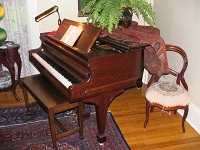
An owner of a parlor (homesize) grand piano has the good fortune to be able to play and enjoy the piano of choice for many musicians. With proper maintenance, a quality smaller grand will give outstanding performance for generations of musicians. The tone and touch of a grand piano set it apart from other types of pianos. Since the design of the grand piano was perfected early in the previous century, no matter what the age of the instrument, the owner certainly has the “top the line” when it comes to performance and sound.
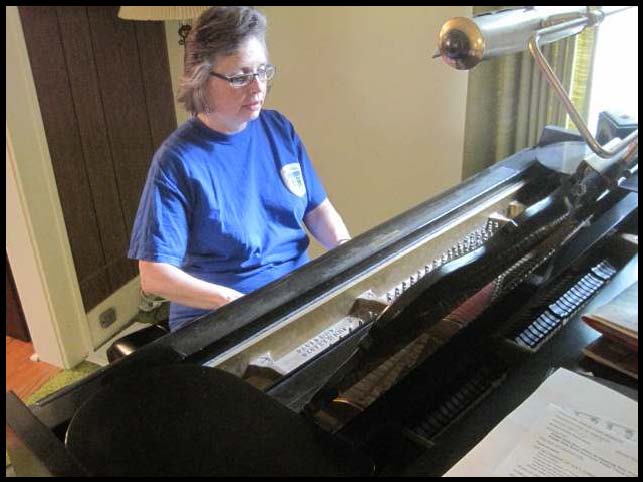 Sitting down to play on a freshly tuned grand piano is a wonderful experience!
Sitting down to play on a freshly tuned grand piano is a wonderful experience!
Tuning: With any acoustic piano, following a regular tuning schedule is essential for the piano to perform up to its potential. All pianos go out of tune over time because of a variety of factors such as seasonal swings in humidity levels. An important key to a piano sounding its best is to keep it in proper tune by having it professionally serviced on a regular basis. An adequate tuning schedule for a piano being used on a regular basis is a onceayear tuning, usually scheduled for approximately the same time of year each year. For the piano that is being played heavily, a semiannual or quarterly tuning would be better yet.
For a piano currently not being played but which is being maintained for future use, a tuning every other year will usually suffice. Letting an piano go for longer than two years without tuning, however, is not recommended.
Repairs: A grand piano action has thousands of individual parts, and after decades of use, breakage may occur or parts may simply wear out. The good news is that most of the parts found in a grand piano action (the working mechanism) do not often break and those parts that do happen to break or wear out commonly may be either replaced with parts available to the professional piano technician, or repaired to likenew condition.
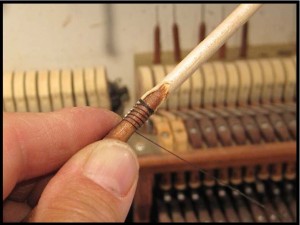 One example of a part which might need to be replaced or repaired on a grand piano would be that of a broken hammer shank. Each shank connects to a hammer, and as such is subject to a great deal of stress and occasional breakage. In the photo left, a new section of shank is spliced to the bottom of an old shank which had broken.
One example of a part which might need to be replaced or repaired on a grand piano would be that of a broken hammer shank. Each shank connects to a hammer, and as such is subject to a great deal of stress and occasional breakage. In the photo left, a new section of shank is spliced to the bottom of an old shank which had broken.
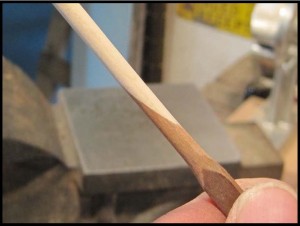 Many times in repairing pianos, a choice has to be made whether to repair the old parts, or simply replace them. With newer pianos of wellknown brands, replacement of worn or broken parts with new parts may be the most practical solution. Other times, when an older or lesser known brand of piano is being worked on, exact replacement parts may not be available. In that type of situation, repairing the old parts may be the best option. In the photo to the right, a welldone splice suffices to repair a broken shank.
Many times in repairing pianos, a choice has to be made whether to repair the old parts, or simply replace them. With newer pianos of wellknown brands, replacement of worn or broken parts with new parts may be the most practical solution. Other times, when an older or lesser known brand of piano is being worked on, exact replacement parts may not be available. In that type of situation, repairing the old parts may be the best option. In the photo to the right, a welldone splice suffices to repair a broken shank.
In certain cases where overall wear and tear is a factor, replacing the entire set of parts with new may be the best option. By doing so, repairs in the foreseeable future will not be needed. The problem is solved, once and for all. This approach is therefore recommended whenever possible.
Other commonly needed repair work on a grand piano would include such jobs as the filing or replacing of worn hammers, installation of a new set of dampers, replacement of broken ivories or the installation of an entirely new set of keytops. The photos below illustrate these often needed repairs:
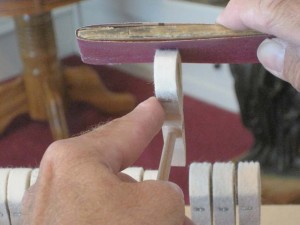 An old, worn-out set of hammers may very well need attention in a piano that has been played hard over the years. Careful reshaping of the hammerheads is sometimes possible, as is being done in the photo to the left. At other times where the old hammers are badly worn, the installation of a new set of hammers is necessary.
An old, worn-out set of hammers may very well need attention in a piano that has been played hard over the years. Careful reshaping of the hammerheads is sometimes possible, as is being done in the photo to the left. At other times where the old hammers are badly worn, the installation of a new set of hammers is necessary.
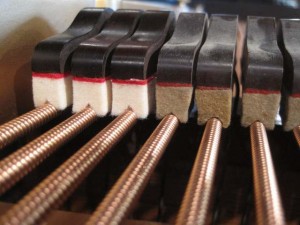 Bass dampers are being replaced in the photo to the right. This will result in an improvement to the cessation of sound once notes are released. Old dampers of ten become hard, and don’t quiet the strings as quickly as intended.
Bass dampers are being replaced in the photo to the right. This will result in an improvement to the cessation of sound once notes are released. Old dampers of ten become hard, and don’t quiet the strings as quickly as intended.
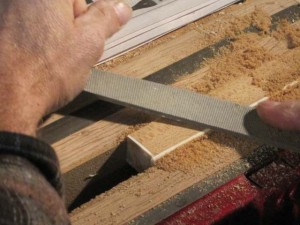 Original ivory in good condition on an older grand piano is a definite plus. A few chipped keys may oftentimes be replaced or repaired. In cases where the old keys are badly worn, however, installing a new set of keytops (shown being fitted to the keysticks) will benefit the appearance of the piano.
Original ivory in good condition on an older grand piano is a definite plus. A few chipped keys may oftentimes be replaced or repaired. In cases where the old keys are badly worn, however, installing a new set of keytops (shown being fitted to the keysticks) will benefit the appearance of the piano.
For a grand piano to perform at its peak, the first step is to get it into tune, and to repair all broken or worn parts. When this has been done, the piano is ready to be “regulated” and “voiced.” Regulation refers to the procedure of adjusting all the moving parts of the piano action so that the mechanism is performing in peak form, with no wasted motion. Voicing refers to evening out and improving the tonal quality of the piano by making careful adjustments to the hammers of the piano.
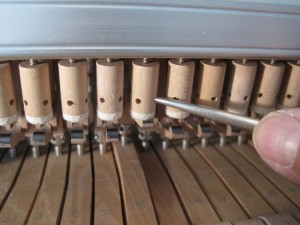 When a grand piano is in perfect regulation, each hammer is propelled almost all the way to the strings by the action. At the last possible moment, the hammer is released to strike the strings under its own momentum. In the photo to the right, adjustments are being made to ensure that the hammers release at precisely the right moment.
When a grand piano is in perfect regulation, each hammer is propelled almost all the way to the strings by the action. At the last possible moment, the hammer is released to strike the strings under its own momentum. In the photo to the right, adjustments are being made to ensure that the hammers release at precisely the right moment.
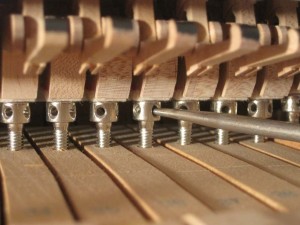 Hammers are adjusted so that they are perfectly level from one end of the action to the other. Here, the height of the hammers is regulated by precise adjustment of the appropriate brass capstans.
Hammers are adjusted so that they are perfectly level from one end of the action to the other. Here, the height of the hammers is regulated by precise adjustment of the appropriate brass capstans.
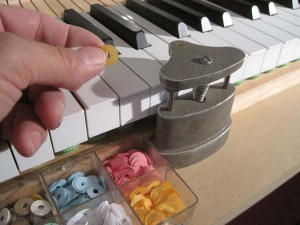 Perfectly level keytops give a grand piano more of a “new” feel when played, and are essential for a piano to look its best. In this photo, a set of grand keys are adjusted to a tolerance of .002″.
Perfectly level keytops give a grand piano more of a “new” feel when played, and are essential for a piano to look its best. In this photo, a set of grand keys are adjusted to a tolerance of .002″.
While tuning, repairs, regulation and voicing are the job of the technician, seeing to it that the piano is placed in an appropriate spot within the home is up to the owner. What is needed, as much as possible, is a location where temperature and humidity are kept at moderate levels yearround. Drafty locations, or areas where wide swings in either temperature or humidity occur (unheated porches, moldy basements, etc.) are unsuitable for a piano. In particular avoid placing any piano too close to either of the following:
 1. Heat or AC ducts.
1. Heat or AC ducts.
 2. Drafty windows.
2. Drafty windows.
Note: Effective humidity control equipment, either for the home in general or the piano in particular, will aid in keeping your piano in top form.
 To keep a quality grand piano performing at its best so that everyone who sits down will enjoy their musical experience, it makes sense to come up with a plan for maintaining the piano which fits both your budget and expectations. If you would like, I would be happy to schedule a time that we could sit down together and go over the specific repairs your piano would benefit from and come up with a plan for a regular maintenance schedule for tuning and regulation.
To keep a quality grand piano performing at its best so that everyone who sits down will enjoy their musical experience, it makes sense to come up with a plan for maintaining the piano which fits both your budget and expectations. If you would like, I would be happy to schedule a time that we could sit down together and go over the specific repairs your piano would benefit from and come up with a plan for a regular maintenance schedule for tuning and regulation.
 A 125 year-old grand having undergone extensive work is ready to be put back into service.
A 125 year-old grand having undergone extensive work is ready to be put back into service.